Non - Xeriscape.
Common Landscape Plants. Shrubs, Flowers, & Trees.
For The Arizona Desert Environment
Pictures, Photos, Images,
Descriptions, & Reviews.
Cottonwood Trees, Populus fremontii.
We Are Proud Of Our SafeSurf Rating!
Click On Any Of The Following Links By Amazon.Com
For Books, & Videos About Wildflowers Of Arizona & The Southwest USA. No Obligation!
 |
| Cottonwood Trees, Populus fremontii. Photo Taken July 05, 2012. Peeples Valley, Arizona. |
|---|
 |
| Cottonwood Trees, Populus fremontii. Ranch Houses Under Cottonwood Tree Grove. Photo Taken July 05, 2012. Peeples Valley, Arizona. |
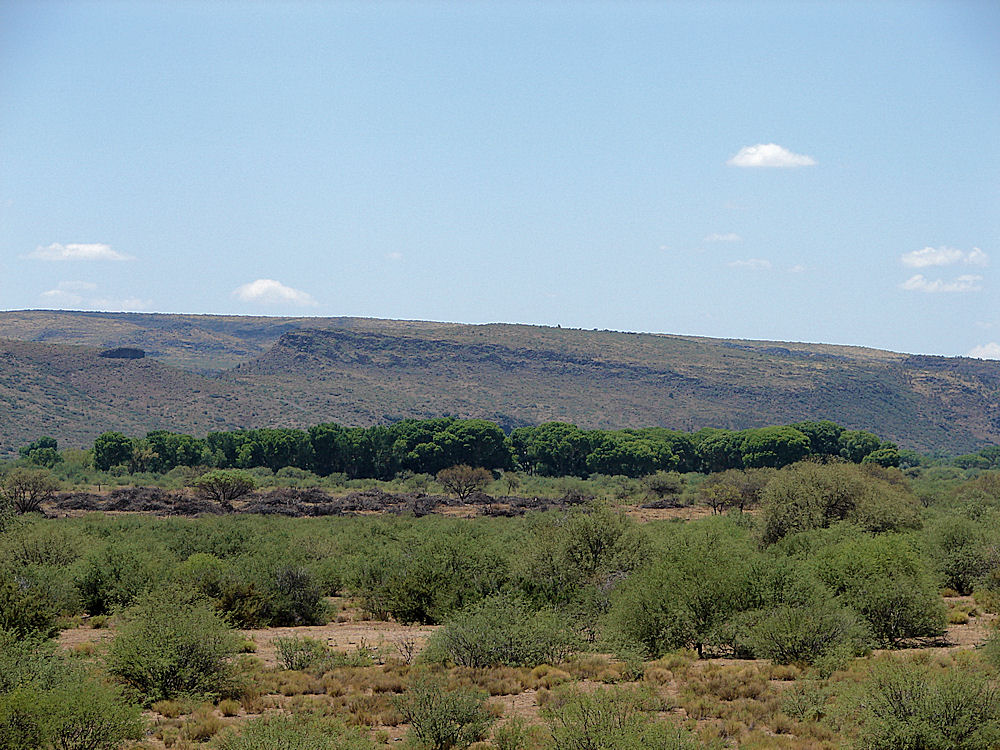 |
| Cottonwood Trees, Populus fremontii. Cottonwood Tree Grove, Near Good Water Source! Photo Taken July 05, 2012. Kirkland, Arizona. |
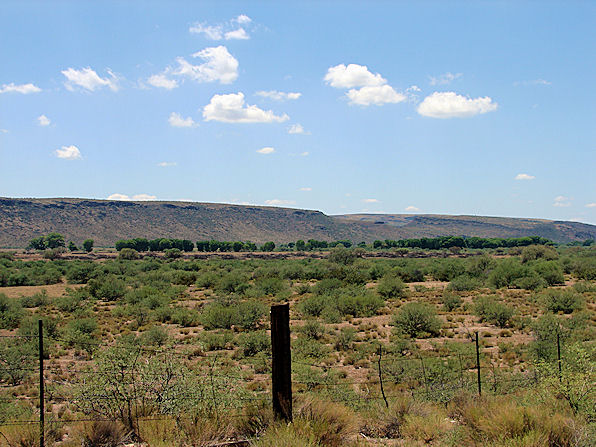 | |
| Cottonwood Trees, Populus fremonii. Are Always Growing Close To Water. These Cottonwood Trees Follow A Stream Bed. We Were Taught To Always Look For Cottonwood Trees, If We Were Lost In The Desert, & We Needed Water! | Cottonwood Trees, Populus fremonii. Are Always Growing Close To Water. These Cottonwood Trees Follow A Stream Bed. We Were Taught To Always Look For Cottonwood Trees. If We Were Lost In The Desert, & We Needed Water! |
|---|---|
 | 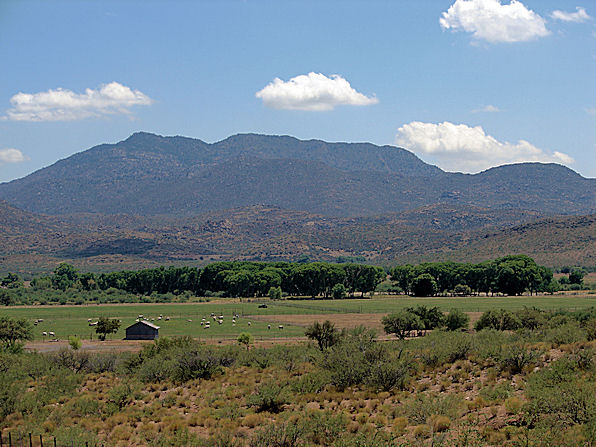 |
| Cottonwood Trees, Populus fremonii. Are Always Great Natural Shade For Livestock. Beekeepers Can Also Keep Bee Hives Under Their Natural Shade. The Gentle Honey Bee Needs Shade & Water In The Summer. | Cottonwood Trees, Populus fremonii. Are Always Great Natural Shade For Livestock. Beekeepers Can Also Keep Bee Hives Under Their Natural Shade. The Gentle Honey Bee Needs Shade & Water In The Summer. |
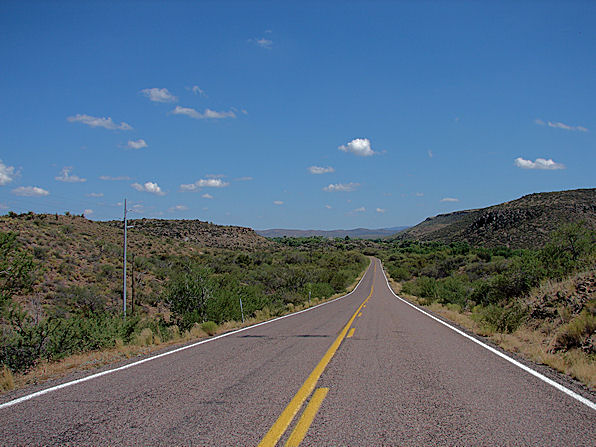 | |
| Cottonwood Trees, Populus fremonii. Are Always Growing Close To Water. These Cottonwood Trees Follow A Stream Bed. | Cottonwood Trees, Populus fremonii. Are Always Growing Close To Water. These Cottonwood Trees Follow A Stream Bed. It Goes As Far As You Can See, In Center Background! |
 /
/

 |
| Cottonwood Trees, Populus fremontii. Photo Taken June 16, 2003. Near Date Creek, Arizona. |
|---|
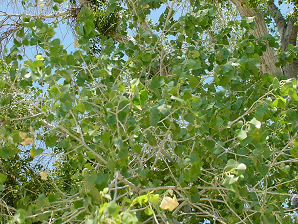 |  |
| Cottonwood Trees. | Populus fremonii Always Grow Close To Water. |
|---|---|
 |  |
| Cottonwood Leaves. | Cottonwood Leaf. |
 /
/

CottonWood Tree.
We wish to thank Wikipedia, the free encyclopedia for some of the information on this page. We share images and information with Wikipedia. In the 1940's, when the author of this page, George DeLange, was growing up in the area of Glendale and Phoenix, Arizona; he remembers that almost every roadway was lined with cottonwood trees, for shade. Many of the farmers also had cottonwoods planted on their farms, near their homes, also for shade. Later on, it was determined that these trees used too much water and their use became less popular. There are still groves of these trees in Arizona, which are growing wild; so we are including this plant on our list of Arizona Wildflowers. Populus fremontii, the Fremont cottonwood or Alamo cottonwood, is a cottonwood (and thus a poplar) native to riparian zones of the Southwestern United States and far northern Mexico. The tree grows near streams, rivers, springs, wetlands, and well-watered alluvial bottomlands at elevations below 7,000 feet elevation. Populus fremontii is a large tree growing from 39 feet to 115 feet in height with a wide crown, with a trunk up to 5 feet in diameter. The bark is smooth when young, becoming deeply fissured with whitish cracked bark on old trees. The Inflorescence consists of a long drooping catkin, which blooms from March to April. The fruit is a wind dispersed achene, that appears to look like patches of cotton hanging from limbs, thus the name cottonwood. The 1.2 inch to 2.8 inch long leaves, are cordate (heart-shaped) with an elongate tip, with white veins and coarse crenate teeth along the sides, glabrous to hairy, and often stained with milky resin. Autumn colors occur from October-November, mainly a bright yellow, also orange, they rarely are red in color. The largest Fremont Cottonwood known to exist in the United States nowdays, grows in Santa Cruz County in southern Arizona. In 1996 it had a measured circumference of 42 feet, a height of 92 feet, and a spread of 108 feet. Two subspecies are currently recognized. Some confusion exists due to hybridization with a Rio Grande subspecies of Populus deltoides subsp. wislizeni which had originally placed this Eastern Cottonwood subspecies as a P. fremontii subspecies in section Aigeiros, but it was removed in 1977. Populus fremontii subsp. fremontii, with synonyms P. f. var. arizonica Sarg. and P. f. var. macdougalii (Rose) Jeps. from California and west of the Continental Divide is listed, as well as, Populus fremontii subsp. metesae Eckenwal, of the arid areas of Mexico and widely planted elsewhere, generally east of the Continental Divide.
Today, Populus fremontii has several uses for planting.
In the past, Fremont cottonwood was used in the past by settlers and ranchers for fuel and fence posts. The author of this page recalls the wood being used for fence posts on family farms. In the past and today, the Native Americans in the Western United States and Mexico have used parts of the Fremont cottonwood variously for a medicine, in basket weaving, tool making, and for musical instruments. For example, the inner bark of Fremont cottonwood contains vitamin C and was chewed as an antiscorbutic, or treatment for vitamin C deficiency. The barks and leaves could be used to make poultices to reduce inflammation or to treat wounds. The Pima people of southern Arizona and northern Mexico lived along Sonoran Desert watercourses and they used twigs from the tree in the fine and intricate baskets they wove. The Cahuilla people of southern California used the tree's wood for tool making, the Pueblo peoples for drums, and the Lower Colorado River Quechan people in ritual cremations. The Hopi Indians of Arizona consider the cottonwood tree sacred and carve Kachina dolls from the roots of the tree. They believe the rustle of the wind through the quaking leaves to be the gods speaking to their people. Here is another excellent article about Cottonwood Trees - FREMONT�S COTTONWOOD Plant Guide from the USDA NRCS National Plant Data Center & New Mexico Plant Materials Center.
Quick Notes:
Height: Height usually to about 60 feet. Spread of 50 to 60 feet. We have personally seen cottonwood trees over 100 feet tall.
Flowers: Dioecious, males and females as hanging catkins, 2 to 4 inches long, yellow-green, appearing in early spring before the leaves.
Flowering Time: Usually in Mid - March. But can bloom, May to September.
Leaves: Alternate, simple, broadly cordate (triangular), coarsely crenate, 2 to 4 inches long, petiole flattened, shiny green above, sometimes pubescent beneath.
Trunk: Up to 2 - 5 feet in diameter.
Soil pH requirements:
Sun Exposure:
Elevation: Can be found from 0 - 7,000 Feet.
Habitat: Found along riparian area washes where water is near the surface. Used to be a very common landscape plant in Arizona.
Miscellaneous: Tree Photos Taken Near Date Creek, Arizona On June 13, 2003. Bottom Two Photos June 18, 2005 Linx Creek, Arizona. Most large photos taken July 05, 2012 between Peeples Valley & Hillside, Arizona.
|
We Are Proud Of Our SafeSurf Rating!



We Are Proud Of Our SafeSurf Rating!
Click On Any Of The Following Links By Amazon.Com
For Books, & Videos About Xerioscape Plants Of Arizona & The Southwest USA. No Obligation!
| © 1966 - Present, Audrey, Eve, & George DeLange |


